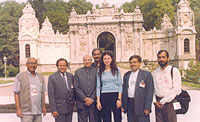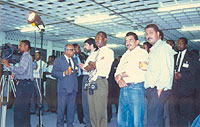|
Power Trips...
|
|
|
 |
Passage
To Turkey
With former minister of state for external affairs Sikandar Bakht (3rd from left) in Istanbul |
|
The PM ritualistically gives a press conference midway through the journey, but much of what he says is drowned by the aircraft’s deafening drone. After every such “encounter” with the PM the press corps turns to whoever carries a voice-recorder. Sometimes I managed to put my micro-recorder close to the PM, and had to play it again and again so that my colleagues could check the accuracy of their notes.
Once Air-India I made an unscheduled landing at Paris because its cockpit windshield cracked in midair. After it taxied to a secluded part of the aerodrome, our ambassador drove the PM around the city. For four long hours, until a substitute Air-India liner arrived, we killed time in the cramped lounge, where there weren’t enough stools or chairs for all, moaning the loss of an opportunity to take a peek at the Eiffel Tower. After the substitute plane was airborne I remembered I had forgotten two hand bags in the disabled aircraft’s overhead rack. It was a pleasant surprise to have the bags home delivered by Air-India a day or two later.
|
|
Indifference towards visiting heads of govt from South Asia, not to speak of lesser functionaries, is not peculiar to the US media. The German media ignored Rao’s visit to Bonn
|
Beating the deadline is a major worry for journalists covering VVIP visits to the U.S. because of the time difference. The first ever joint press conference of a US president and an Indian PM was held in Washington in 1994. President Bill Clinton and PM P.V. Narasimha Rao ambled into the White House media centre, around 2 p.m. (midnight in India). Clinton virtually monopolised the interaction, sparing Rao little time to speak.
We had become restless waiting in the White House for over two hours, for our deadline was only minutes away. None of us wished our morning editions to miss the historic event. Even as security agencies enforced rigid standards of security check, our entry into the White House was hassle free. No hiccups occurred in accessing the press gallery of the US Congress a day later. I was struck by the relatively small size of the room where for generations US presidents have interacted with the media. Stickers carrying the names of leading American newspapers on the front row chairs caught my attention.
|
|
When I asked about Clinton’s philandering, he wasn’t humoured. The American journalist assured me these “sinister spiels” were the work of muckrakers in the British media
|
We were back in our hotel minutes after the press conference. Those were early days of computer laptops. I composed my copy on my laptop quickly enough but ran into trouble transmitting it. Minutes ticked away and sweat lined my forehead. I called the hotel phone operator to check if the line was O.K. She confirmed it was. My lack of computer expertise however botched the transmission. A fax machine saved the day. Some journalists, however, chose the softer option of asking their night editors to use the agency copy under their byline.
We churned out hundreds of thousands of words about the PM’s visit but I didn’t read a word about the
Clinton-Rao press conference in any major US daily. Indifference towards visiting heads of government from South Asia, not to speak of lesser functionaries, is not peculiar to the US media. The German media took virtually no notice of Rao’s talks with Chancellor Helmut Kohl and business tycoons on a visit to Bonn. China was the only major country where I found Rao’s visit prominently noticed, albeit not as the lead story. I remember how intensely we speculated for days on end about Rao’s possible meeting with Pakistani Prime Minister Nawaz Sharif at a Jakarta hotel, where they stayed two floors apart, in 1992. Our accounts of their 15-minute tete-a-tete ran to hundreds of words but the rest of the world didn’t bother.
|
 |
AFRICAN SAFARI: The author at Harare, where former PM Deve Gowda took along 15 relatives to a G-15 meet |
|
|
As we waited for the White House press conference, an American journalist chatted me up about Indian politics. The Lewinsky affair had not yet happened but Washington was abuzz with the president’s amorous overdrives. When I bared my curiosity about Clinton’s philandering, he wasn’t
humoured. Tongue-in-cheek the American journalist assured me these “sinister spiels” were the work of muckrakers in the British media, for Englishmen had a low opinion of American politicians. He told me Oxford educated Bill Clinton was a perfect foil for their intellectual chicanery. The message was loud and clear: sexual aberrations hadn’t dented Clinton image as the nation’s idol.
Once in a while a prime ministerial trip could produce hilarious inputs. During his brief stint,
H.D. Deve Gowda didn’t have many chances to go abroad. But when he did he loaded the special flight with his kith and kin. Eyebrows were raised when as many as 15 offspring of the Gowda clan stepped out of Air-India I at Harare, where he went for a G-15 meet. The Zimbabweans had to stretch their meagre resources in placing enough cars to ferry them. A Delhi newspaper headline “Gowda’s 15 for G-15” summed it up all. The “poor farmer” had to do a lot of explaining when questions were raised about the Air-India plane making a special trip for his extended family to South Africa and back to Zimbabwe.
|
|
|
|
May 2006
|
|

|
|
|
|